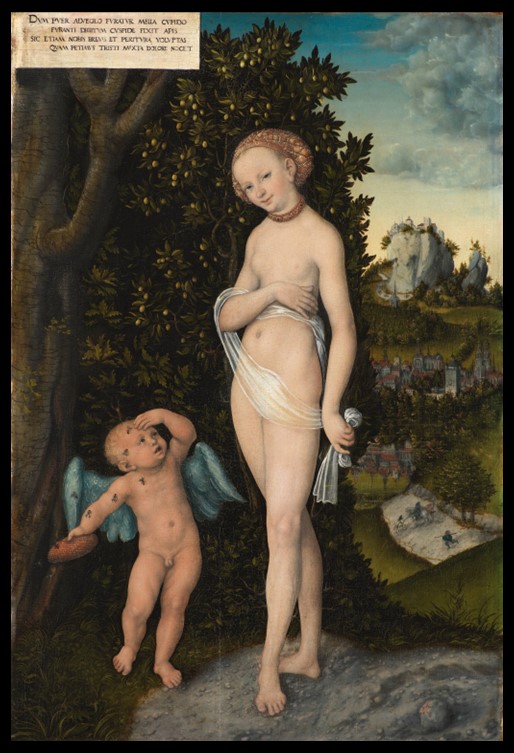
Venus with Cupid Stealing Honey, 1530, Oil on Panel, 38 x 58 cm, Statens Museum for Kunst, Denmark
https://open.smk.dk/artwork/image/KMSsp719
A wicked bee once filching Eros stung, / As from hive unto hive the sly god flew. / Looting the flower-sweet honeycombs among; / With finger-tips all pierced he cried and blew /
His hand, and stamped upon the ground with pain, / And vaulted in the air; to Aphrodite / Sadly he came commencing to complain, / “Although the bee is small his wound is mighty.” / Then said his mother smiling, “Are you not / A creature small just like the bee, I pray? / But ne’ertheless it must not be forgot— / The cruel wounds you deal—how great are they!” Idyll XIX, Eros, and the Bee, attributed to the ancient Greek Poet Theocritus of the 3rd century BC, is the source of inspiration for a number of paintings by Lucas Cranach the Elder depicting an alluring Venus, and Eros, a stolen piece of honeycomb in hand, stung by Bees. My favourite version, in the SMK Art Museum in Denmark, is expecting us to probe and explore… http://nicholasjv.blogspot.com/2009/11/sweetness-of-honey-and-sting-of-bees.html
Venus with Cupid as a honey thief was probably one of the most successful mythology-inspired compositions created by the German artist of the Renaissance period Lucas Cranach the Elder. Scholars suggest there are twenty versions of the same theme, dated between 1527 and 1545, painted by the artist, his workshop, or followers of his theme and style.
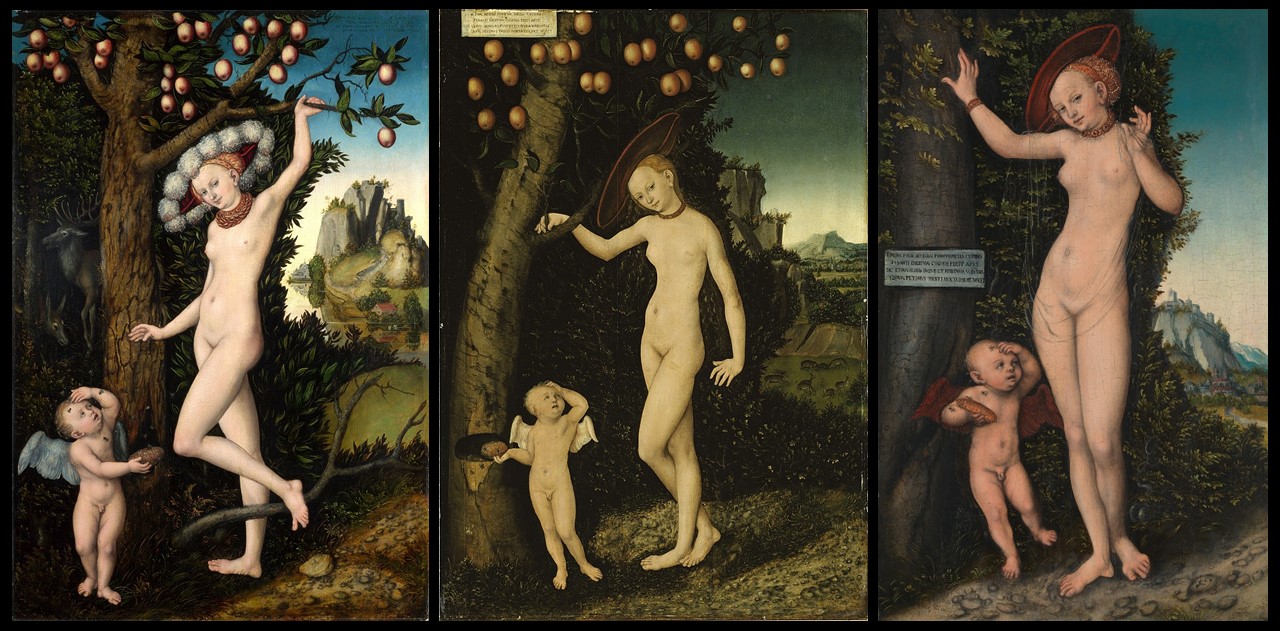
Cupid complaining to Venus, c. 1526–27, Oil on Panel, 81.3×54.6 cm, National Gallery, London, UK
Venus and Cupid as Honey Thief, 1527, on beech wood, 83×58.2 cm, Güstrow Castle, Germany
Venus and Cupid, the Honey Thief, 1529, Oil and Tempera on Beech Wood, 38.1×23.5 cm, Cook collection, National Gallery, London UK
https://en.wikipedia.org/wiki/Cupid_complaining_to_Venus
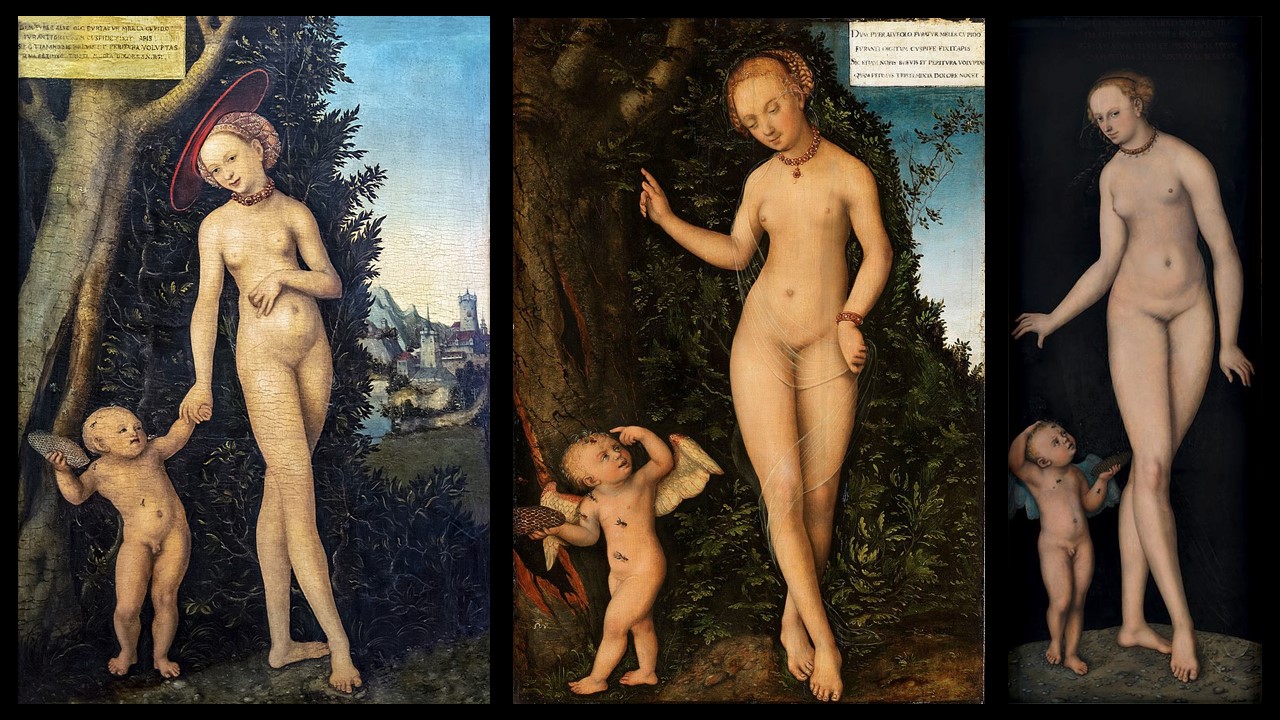
Venus and Cupid, 1531, Oil on Panel, 51×35 cm, Fondation Bemberg, Toulouse, France
Venus and Cupid, the Honey Thief, circa 1537, Oil on Lime Panel, 50.1×34.4 cm,
Germanisches Nationalmuseum, Nuremberg, Germany
Venus with Cupid as a Honey Thief against a Black Background, 1537, Oil on Lime Panel, 175.4×66.3 cm, Bavarian State Painting Collections, Germanisches Nationalmuseum, Munich, Germany
https://en.wikipedia.org/wiki/Cupid_complaining_to_Venus
These paintings depict the same two figures, Venus, the Greek Goddess of beauty and love in glorious nudity, and her son, Eros, god of love as well, holding a stolen piece of honeycomb, stung by bees, and in obvious pain. My favourite painting of Venus with Cupid Stealing Honey is exhibited in the Statens Museum for Kunst in Denmark and combines all the important elements of the composition.
In the upper, left corner of the painting in Denmark, a sign with a reference to Idyll XIX of Theocritus clearly explains the theme. “As Cupid was stealing honey from the hive / A bee stung the thief on the finger / And so do we seek transitory and dangerous pleasures. / That are mixed with sadness and bring us pain.” The wording does not reproduce Theocritus’ exact Greek text, but rather a Latin epigram based on the poem. Painted on a cream-coloured ‘panel’ on the upper left side of the painting, the epigram is related to the work of the great German humanist Philipp Melanchthon. with whom Cranach was closely connected in producing illustrations for Luther’s Bible translation. (A short but comprehensive presentation of Philipp Melanchthon’s contribution to Humanism in Germany… Melanchthon: A German Humanist by A. Pelzer Wagener, The Classical Weekly, Vol. 22, No. 20 (Mar. 25, 1929), pp. 155-160 (6 pages). I particularly like his point of view that Greek and Latin should be studied side by side by all who sought to grasp the substance of the involved rather than its shadow”. https://www.jstor.org/stable/4389299?read-now=1&seq=2#page_scan_tab_contents) https://open.smk.dk/artwork/image/KMSsp719
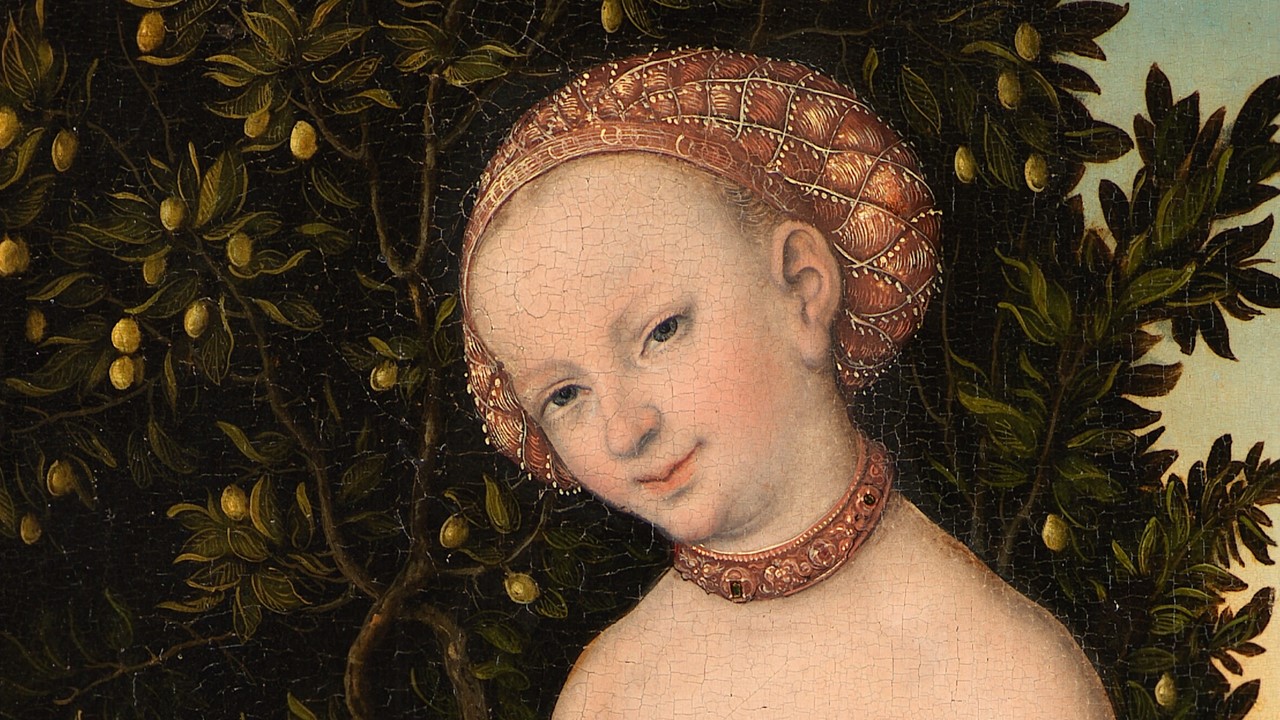
Venus with Cupid Stealing Honey (Detail), 1530, Oil on Panel, 38 x 58 cm, Statens Museum for Kunst, Denmark
https://open.smk.dk/artwork/image/KMSsp719
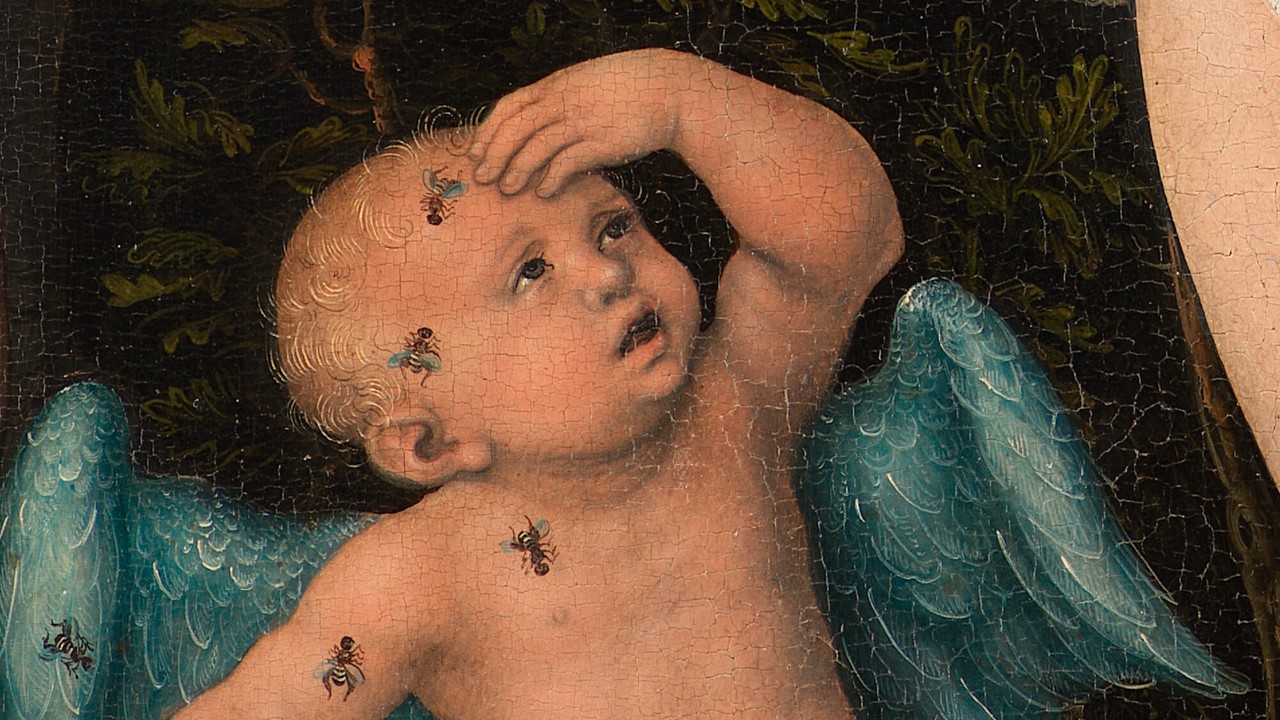
Venus with Cupid Stealing Honey (Detail), 1530, Oil on Panel, 38 x 58 cm, Statens Museum for Kunst, Denmark
https://open.smk.dk/artwork/image/KMSsp719
Examining Cranach’s painting at SMK, depicting Venus, Eros, and the landscape that surrounds them, I see, compared to the rest of Cranach’s paintings of the same theme. elegance and grace, an understated sense of humor, and a subtle mood of morality. The Landscape, in a true Norther European Renaissance tradition, is glorious, lush, and detailed. It invites you to examine the luxurious foliage, the city reflections on the depicted water, and the travelers’ mannerisms. Eros, a blond toddler with blue wings, ever so charming, is displaying his surprise and pain with gusto. Venus looks at the viewer, and laughs, explaining to him that the effect is comparable to the wounds he himself inflicts on all those struck by his arrows. What a painting to consider Love, Euphoria, and Heartache!
For a Student Activity, please… Check HERE!
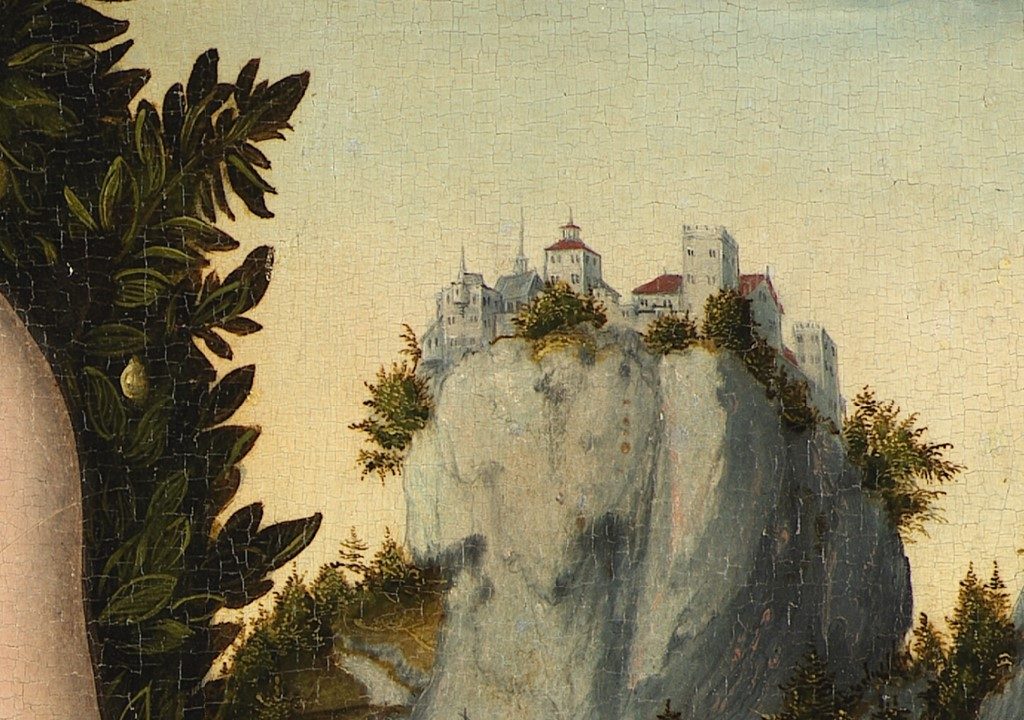
Venus with Cupid Stealing Honey (Detail), 1530, Oil on Panel, 38 x 58 cm, Statens Museum for Kunst, Denmark
https://open.smk.dk/artwork/image/KMSsp719